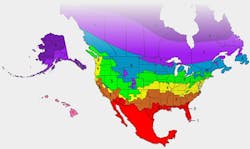Are you getting what the R-value specified and paid for?
The building code prescribed R-values for above deck roof insulation will be increasing again in the near future once the building code agencies adopt the 2012 ASHRAE (American Society of Heating, Refrigeration and Air-Conditioning Engineers) criteria. For Zones 4 and 5 the R-value will need to be R-25, Zone 6 – R-30 and Zones 7 and 8 up to R-35.
Polyisocynaurate insulation is one of the more commonly used insulation types in the roofing industry. Most manufacturers of polyisocyanurate insulation use the long-term thermal resistance (LTTR) method of determination. LTTR method is defined by ASTM C1303, “Standard Test Method for Predicting Long-Term Thermal Resistance of Closed-Cell Foam Insulation.” The LTTR method provides for thin-slicing test specimens, which accelerates their aging process. The specimens’ R-value is tested at a 75 degree Fahrenheit (F) laboratory condition at various defined times producing an R-value versus time relationship. The resulting LTTR is calculated as a 15-year time-weighted average of the tested values and it closely approximates the R-value after five years of aging under controlled laboratory conditions.
Although the LTTR method of R-value determination and reporting may be appropriate for laboratory analysis, research comparison and procurement purposes, NRCA (National Roofing Contractors Association) does not consider use of LTTR to be appropriate for design and in-service purposes.1 This position is consistent with NRCA’s longstanding position that the published R-values for polyisocyanurate and polyurethane foams are not consistent with actual in-service performances of these products.
When designers use polyisocyanurate insulation, NRCA recommends they determine their thermal calculations using an in-service R-value of 5.0 per inch thickness in heating conditions and 5.6 per inch thickness in cooling conditions. Designers should use the R-value for heating conditions or cooling conditions based on the predominant condition for the climate where the building being considered is located. The following table provides LTTR and NRCA recommended design R-values for commonly available thicknesses of polyisocyanurate insulation.
Polyisocyanurate
Thickness,
inches LTTR NRCA Recommended
Design R-values
Heating Conditions Cooling Conditions
1.0 6.0 5.0 5.6
1.25 7.5 6.3 7.0
1.5 9.0 7.5 8.4
1.75 10.5 8.8 9.8
2.0 12.1 10.0 11.2
2.3 14.0 11.5 12.9
2.5 15.3 12.5 14.0
Another factor to consider when specifying the R-value for a roofing project is the fact that installation of the insulation with a metal fastener (screw) through the entire thickness of the insulation produces a thermal bridge that reduces the effective R-value even more. A study published in 1986 shows that installation of a metal fastener with a metal cap creates and R-value reduction of 3% for 2 inch thickness
up to 8% for 6 inch thickness.2 This is based on a typical fastener density of one fastener per 2 square feet of board area for a fully adhered membrane application.
An example of the “true” R-value of an R-25 insulation system that may be seen in specifications for the Chicago area would be a layer of 2.3 inch and 1.75 inches of polyisocyanurate insulation. Both layers would be mechanically fastened from the top layer into a metal deck. Using just the LTTR method this provides the code required R-value.
Chicago is considered a heating climate. Using the NRCA recommended R-value would only result in a value 20.3. Further reduction of the “true” R-value would include a 7% reduction per the 1986 study. This results in an actual design R-value of 18.9, far less than the code required and what the client thought they purchased.
Both of these factors can play into the direction the construction industry is going with the analysis of the “projected design” energy savings versus the actual energy savings of the constructed project. Designers would be prudent to take these factors into consideration for such projects as well as all projects. One way to minimize the R-value loss of fastening insulation to a metal deck would be to only fasten the bottom layer with the fastener and attach the upper layers with adhesive or bitumen. Doing this according to the 1986 study “the reduction in overall thermal resistance is about of factor of three less than that for the case in which the metal fastener penetrates the entire insulation layer”.2
Darrell Smith, PE, RRC is Civil Engineer - Building Envelope/Roof Consultant
REFERENCES
1. NRCA Roofing Manual: Membrane Roof Systems-2011, National Roofing Contractors Association
2. “Burch, Douglas M., “A Heat Transfer Analysis of Metal Fasteners in Low-Slope Roofs,” ASTM STP 959, 1986
About the Author
Darrell Smith
PE, RRC
Darrell Smith is the executive director of the International Window Film Association, a role that he has held for over 25 years. He represents the interests of the window film industry to the National Fenestration Rating Council, the Glass Association of North America, the Protective Glazing Council International, the Glazing Industry Code Committee, the California Public Utilities Commission and the California Energy Commission, the International Code Committees and the U.S. Department of Energy and U.S. Environmental Protection Agency.
